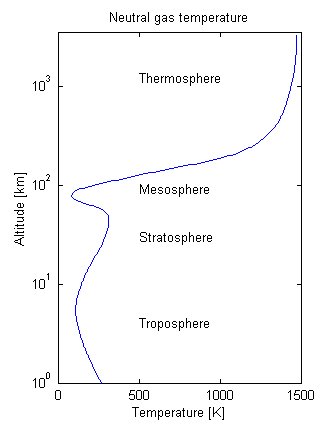 Atmosphere
(Earth's)
Atmosphere
(Earth's) Atmosphere
(Earth's)
Atmosphere
(Earth's)spaceweb@oulu.fi - last update: 29 November 1998, 2350 UT (RR)
 Introduction
Introduction Because of the Earth's gravity, atmosphere is horizontally stratified (see, e.g., Kelley, 1989). Its structure can be organized by using the neutral gas temperature, as shown in the figure from mid-latitudes (note the logarithmic altitude scale).
When going upward from the ground within the lowermost atmospheric region, troposphere, the temperature decreases up to about 10 km altitude (tropopause). Above that, in the stratosphere, the ozone (O3) starts absorbing the ultraviolet solar radiation, and temperature starts rising again. At about 50 km altitude (stratopause) this effect ends, and radiative cooling creates the mesospheric temperature minimum at about 80 km. Above mesopause the temperature starts rising again, now very fast, and we reach the hot thermosphere. The absolute temperature of the thermosphere depends on the solar activity, being between about 700 and 2500 K. The temperature increase is again explained by solar UV radiation. Here the radiation also ionizes the neutral atmosphere, creating the ionosphere. Because both the ground and ionosphere are better conductors than the atmosphere, a special cavity is formed: see Schumann resonances.
| Atmospheric constituents at ground level [%] |
|
|---|---|
| N2 | 78.1 |
| O2 | 20.9 |
| Ar | 0.93 |
| CO2 | 0.035 |
| Ne | 0.0018 |
| He | 0.00052 |
| CH2 | 0.0002 |
| Kr | 0.00011 |
| H2 | 0.00005 |
| Xe | 0.00001 |
There is much less variability in density and composition of the atmosphere than in the temperature. The density decreases monotonously with altitude, and the composition (see table) stays well mixed up to turbopause at about 100 km altitude. Above this turbosphere (or homosphere), heterospheric composition starts showing variability with the altitude, and finally in the upper heterosphere the light helium and hydrogen are the most typical gases.
The upper thermospheric dynamics are typically discussed in terms of wind patterns, since the neutral winds there are driven in situ by solar heating, Joule heating, and momentum transfer from plasma, and even precipitation (e.g., Killeen et al., 1988; Walterscheid and Lyons, 1989). This means that the coupling to ionosphere is important. On the other hand, the lower thermospheric (corresponding to ionospheric E layer) dynamics are discussed in terms of tidal modes and gravity waves originating from below, troposphere and stratosphere (tropospheric weather fronts, tornadoes and thunderstorms, etc.).
There is one important, indirect way the atmosphere is coupled to the Sun's activity via galactic cosmic rays. In addition, man-made atmospheric CO2 increase can affect thermospheric temperatures. See global change for more information.
See also